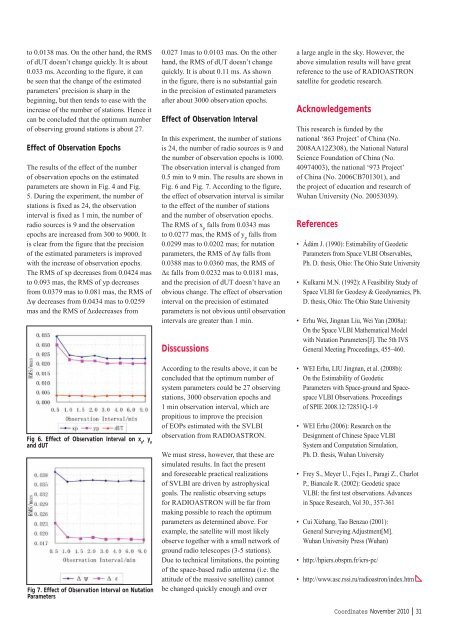Co-ordinates
Co-ordinates
Co-ordinates
Create successful ePaper yourself
Turn your PDF publications into a flip-book with our unique Google optimized e-Paper software.
to 0.0138 mas. On the other hand, the RMS<br />
of dUT doesn’t change quickly. It is about<br />
0.033 ms. According to the figure, it can<br />
be seen that the change of the estimated<br />
parameters’ precision is sharp in the<br />
beginning, but then tends to ease with the<br />
increase of the number of stations. Hence it<br />
can be concluded that the optimum number<br />
of observing ground stations is about 27.<br />
Effect of Observation Epochs<br />
The results of the effect of the number<br />
of observation epochs on the estimated<br />
parameters are shown in Fig. 4 and Fig.<br />
5. During the experiment, the number of<br />
stations is fixed as 24, the observation<br />
interval is fixed as 1 min, the number of<br />
radio sources is 9 and the observation<br />
epochs are increased from 300 to 9000. It<br />
is clear from the figure that the precision<br />
of the estimated parameters is improved<br />
with the increase of observation epochs.<br />
The RMS of xp decreases from 0.0424 mas<br />
to 0.093 mas, the RMS of yp decreases<br />
from 0.0379 mas to 0.081 mas, the RMS of<br />
Δψ decreases from 0.0434 mas to 0.0259<br />
mas and the RMS of Δεdecreases from<br />
Fig 6. Effect of Observation Interval on x p , y p<br />
and dUT<br />
Fig 7. Effect of Observation Interval on Nutation<br />
Parameters<br />
0.027 1mas to 0.0103 mas. On the other<br />
hand, the RMS of dUT doesn’t change<br />
quickly. It is about 0.11 ms. As shown<br />
in the figure, there is no substantial gain<br />
in the precision of estimated parameters<br />
after about 3000 observation epochs.<br />
Effect of Observation Interval<br />
In this experiment, the number of stations<br />
is 24, the number of radio sources is 9 and<br />
the number of observation epochs is 1000.<br />
The observation interval is changed from<br />
0.5 min to 9 min. The results are shown in<br />
Fig. 6 and Fig. 7. According to the figure,<br />
the effect of observation interval is similar<br />
to the effect of the number of stations<br />
and the number of observation epochs.<br />
The RMS of x p falls from 0.0343 mas<br />
to 0.0277 mas, the RMS of y p falls from<br />
0.0299 mas to 0.0202 mas; for nutation<br />
parameters, the RMS of Δψ falls from<br />
0.0388 mas to 0.0360 mas, the RMS of<br />
Δε falls from 0.0232 mas to 0.0181 mas,<br />
and the precision of dUT doesn’t have an<br />
obvious change. The effect of observation<br />
interval on the precision of estimated<br />
parameters is not obvious until observation<br />
intervals are greater than 1 min.<br />
Disscussions<br />
According to the results above, it can be<br />
concluded that the optimum number of<br />
system parameters could be 27 observing<br />
stations, 3000 observation epochs and<br />
1 min observation interval, which are<br />
propitious to improve the precision<br />
of EOPs estimated with the SVLBI<br />
observation from RADIOASTRON.<br />
We must stress, however, that these are<br />
simulated results. In fact the present<br />
and foreseeable practical realizations<br />
of SVLBI are driven by astrophysical<br />
goals. The realistic observing setups<br />
for RADIOASTRON will be far from<br />
making possible to reach the optimum<br />
parameters as determined above. For<br />
example, the satellite will most likely<br />
observe together with a small network of<br />
ground radio telescopes (3-5 stations).<br />
Due to technical limitations, the pointing<br />
of the space-based radio antenna (i.e. the<br />
attitude of the massive satellite) cannot<br />
be changed quickly enough and over<br />
a large angle in the sky. However, the<br />
above simulation results will have great<br />
reference to the use of RADIOASTRON<br />
satellite for geodetic research.<br />
Acknowledgements<br />
This research is funded by the<br />
national ‘863 Project’ of China (No.<br />
2008AA12Z308), the National Natural<br />
Science Foundation of China (No.<br />
40974003), the national ‘973 Project’<br />
of China (No. 2006CB701301), and<br />
the project of education and research of<br />
Wuhan University (No. 20053039).<br />
References<br />
• Ádám J. (1990): Estimability of Geodetic<br />
Parameters from Space VLBI Observables,<br />
Ph. D. thesis, Ohio: The Ohio State University<br />
• Kulkarni M.N. (1992): A Feasibility Study of<br />
Space VLBI for Geodesy & Geodynamics, Ph.<br />
D. thesis, Ohio: The Ohio State University<br />
• Erhu Wei, Jingnan Liu, Wei Yan (2008a):<br />
On the Space VLBI Mathematical Model<br />
with Nutation Parameters[J]. The 5th IVS<br />
General Meeting Proceedings, 455–460.<br />
• WEI Erhu, LIU Jingnan, et al. (2008b):<br />
On the Estimability of Geodetic<br />
Parameters with Space-ground and Spacespace<br />
VLBI Observations. Proceedings<br />
of SPIE 2008.12:72851Q-1-9<br />
• WEI Erhu (2006): Research on the<br />
Designment of Chinese Space VLBI<br />
System and <strong>Co</strong>mputation Simulation,<br />
Ph. D. thesis, Wuhan University<br />
• Frey S., Meyer U., Fejes I., Paragi Z., Charlot<br />
P., Biancale R. (2002): Geodetic space<br />
VLBI: the first test observations. Advances<br />
in Space Research, Vol 30., 357-361<br />
• Cui Xizhang, Tao Benzao (2001):<br />
General Surveying Adjustment[M].<br />
Wuhan University Press (Wuhan)<br />
• http://hpiers.obspm.fr/icrs-pc/<br />
• http://www.asc.rssi.ru/ra dioastron/index.htm<br />
<strong>Co</strong><strong>ordinates</strong> November 2010 | 31
















